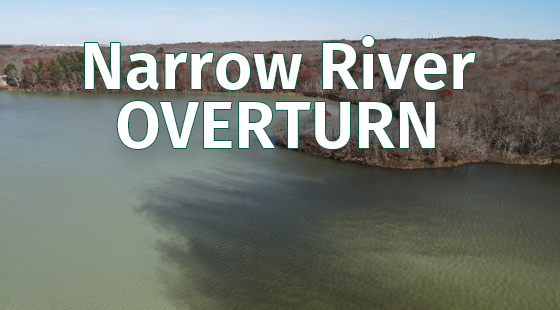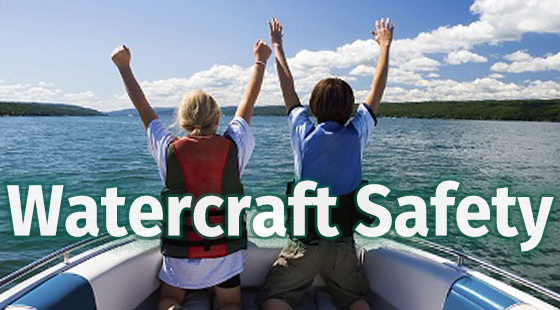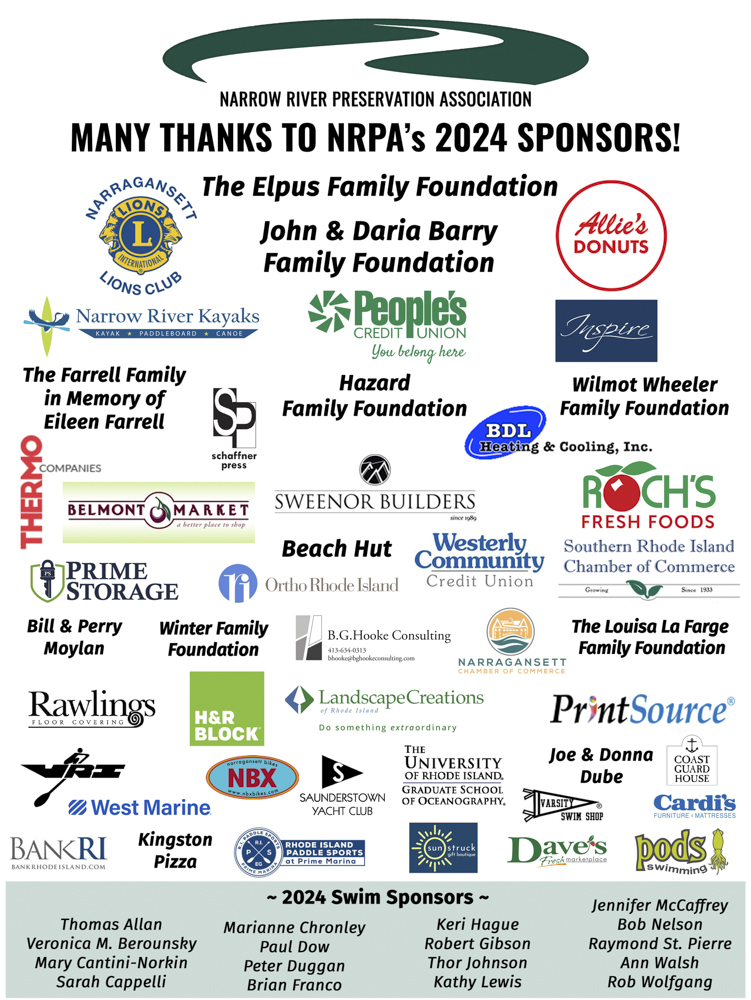Narrow River Preservation Association and Narrow River Land Trust are delighted to provide our live webcam on an active osprey nest along the Narrow (Pettaquamscutt) River. Make sure you turn on the sound! We use infrared light for nighttime viewing. Infrared is not visible to the ospreys or to humans, however, the video camera can capture the images.
The osprey have left New England to spend the winter in South America. We expect them to return to our area in March for the breeding season.
Please scroll down the page for videos of activity at the nest.
This is a wild osprey nest and anything can happen. While we hope that healthy osprey chicks will end up fledging from the nest each season, things like sibling rivalry, predators, and natural disaster can affect this osprey family and may be difficult to watch. As hard as it may be to see anything happen to our osprey, we will let nature take its course and not intervene.
Operating costs of this webcam have been donated in loving memory of Eileen Farrell by her family.
- Learn all about osprey here!
- For an osprey observation lesson plan click here.
- Find a printable activity sheet here.
Many thanks to all who made this osprey webcam possible!
- The many, many donors who contributed to make this possible! (More than 65 donors!)
- The wonderful folks at Menunkatuck Audubon Society in Connecticut, especially Jim Murtagh and Terry Shaw, who provided countless hours of technical advice and guidance
- Our dedicated volunteers: Craig Wood, Erin Chille, Jason Considine, Trent Daugherty, Barry Devine, Bob Facey, Richard Grant, Jim Kaczynski, Jamie McGregor, Ken McShane, Jonah Namzoff, Zach Namzoff, Jake Pietrzak, Ken Pietrzak, Kyle Sidlik, Sally Sutherland, Eisen Villaluna, Nate Vinhateiro, Jim Vogel
- Narrow River Kayaks
- Narrow River Land Trust
- Schroff Technologies International, Inc.
- The Town of Narragansett
- Chris Powell of the Conanicut Island Raptor Project
- Jon Scoones and the Rhode Island Osprey Monitoring Project at Audubon Society of Rhode Island
- FJNewman & Sons
Want to support the webcam and our many other programs? PLEASE BECOME A MEMBER OF NARROW RIVER PRESERVATION ASSOCIATION!
Osprey chick growth over one season
One of the many remarkable things about osprey is how very quickly the chicks grow to nearly full size over the short breeding season. Join us as we follow one osprey family as they lay eggs, chicks hatch and the chicks grow until they fly south for the winter in 2022.
This video was featured in the 2023 RI Nature Video Festival. Click here to watch the entire festival (75 minutes/16 videos).
Ospreys of Narrow River
Originally presented March 28, 2021 at the On Pettaquamscutt Winter Speaker Series, Craig Wood, Ecologist and Board Member of Narrow River Preservation Association and Narrow River Land Trust, explores the natural history, adaptations, migration and identification of osprey. He also shares the history of NRPA’s osprey education program and shows the behind-the scenes of the osprey webcam.
Importantly, Craig also notes the near-disappearance of osprey in Rhode Island in the 1970s, largely due to the pesticide DDT, and the remarkable recovery of the species since DDT was banned.

2021 Osprey Nest Battle
In 2021, a battle between the female who had raised a family in the nest in 2020 and a new female took place in early April.
This video won Honorable Mention in the 2022 RI Nature Video Festival. See the videos from that festival here.
Narrow River Osprey Family 2020
Enjoy this seven minute review of the year in the life of our osprey family! This film won Honorable Mention in the 2021 Rhode Island Nature Film Festival.
VIDEO CLIPS OF ACTIVITY AT THE NEST
January 25, 2024 – This morning a juvenile Bald Eagle brought the remnants of a smaller bird to the nest. The eagle picked at the food and stayed at the nest site, including the perch, for some time.
September 1, 2022 – This morning, the adult male brings a whole, live Atlantic Needlefish to a chick at the nest. Learn more about Atlantic Needlefish, Strongylura marina here.
June 5, 2022 – After the adult male brings a fish tail to the nest, the female gently tears off small chunks and feeds them to the three chicks.
June 2, 2022 – A third chick hatched and is bring fed with their siblings by the mother.
Osprey eggs are laid a day or two apart and therefore hatch a day or two apart. This year, the eggs were laid April 20, April 23 and some time after that, a third egg was laid (exact date unknown). The chicks hatched May 29, May 30 and June 2.
At the start of the video, the male can be seen in the background approaching the nest with a fish tail, which the mother then feeds to the chicks in small chunks.
June 1, 2022 – This morning at the nest, the adult female has just finished feeding her chicks pieces from a fish tail brought by the male moments earlier. Also visible in this video are some of the characters on the band on the female’s leg. We have not yet been able to see all of the characters on the band, but when we do, we will be able to learn where and when this female was banded.
May 30, 2022 – Two chicks have hatched!!
This video shows the male adult bringing half of a fish to the nest and the female then picking off pieces and gently feeding them to two chicks.
May 25, 2022 – This spring morning, deer can be seen eating and playing on the marsh beyond the osprey nest.
May 16, 2022 – Despite rain, thunder and lightning, the female stays on the nest incubating and protecting her three eggs.
April 20, 2022 – First egg of 2022
The same pair that raised a family in 2020 and 2021 has returned to the nest along Narrow (Pettaquamscutt) River for the 2022 breeding season.
After a few weeks of watching nesting and mating behavior, the female laid an egg on April 20. Shortly after the female lays the egg, the male bring a fish to the nest. He will continue to feed the female by bringing 3-4 fish each day while she incubated the egg and other eggs she may lay. Chicks will hatch in early June.
August 22, 2021 – The chicks are sticking out the high winds and rain brought by Hurricane/Tropical Storm Henri in the nest. Unfortunately, power was lost just after this video clip. We’re hoping that power is restored as soon as the storm is over so the live video will resume.
July 30, 2021 – Shortly after midnight on July 30, the chicks are active in the nest during a lightning storm. One chick poops right onto the cam! Osprey always direct their waste away from the nest to keep the nest clean.
July 28, 2021 – This morning, the first chick fledged (flew away from the nest)! The chick will practice flying and catching fish and is expected to return to the nest so that they can be fed by their parents. While learning, the chick will not catch as many fish as needed to eat, so will depend on the parents to continue feeding them back at the nest.
July 25, 2021 – On a rainy Sunday morning the chicks continue to practice flying. Soon, they will fledge (fly away from the nest), but return to the nest so they can still get meals from their parents.
July 19, 2021 – For a brief moment, a hummingbird flies by and seems to look into the osprey nest.
July 9, 2021 – Despite the rain, the adult female brings a fish to the nest. She eats some of it herself and tears off small bits and feeds them to the chicks. Osprey do not regurgitate food like some other birds.
July 4, 2021 – At the start of this video clip, the adult female is standing on the camera mechanism. Shortly after she lands in the nest, the male brings a fish. The female first eats the fish herself, then tears off pieces and feeds them to one of the chicks while the other stretches their wings.
June 20, 2021 – Enjoy this lightning storm as seen from the nest.
June 7, 2021 – In this video clip, the adult male leaves his perch in the background (lower right of the frame) and brings half of a fish to the adult female, who can be seen feeding two chicks. As is common at this time of year, the Red Winged Blackbird can be observed ‘mobbing’ the adult male in the air as he approaches the nest.
June 4, 2021 – At the start of this video clip, the adult female is in the nest and the adult male is perched on a post on the right side of the nest in the distance. The male brings a piece of fish to the nest and passes it to the female. A chick can be seen in the nest between sticks. The female then tears off pieces of the fish and feeds to the chick. It is possible that she is feeding more than one chick, but we cannot confirm due to the depth of the nest.
April 1, 2021 – It’s no joke! Osprey bond with their nest for life. On March 29, a female arrived at the nest and was accepted by the male, even though she was a different bird from last year. Over a few days, these two engaged in housekeeping together and were even seen starting to copulate. Then on April 1, the female from last year returned and the two females competed for the nest.
Early in the morning of April 1, 2021, a coyote can be seen exploring the marsh.
A bluebird pair visits the nest March 24, 2021, as we await the return of our osprey pair for the season. Learn more about bluebirds here.
In February 2021, a Northern Flicker visited the nest. More info about Northern Flickers here.
On a cold and snowy February afternoon, an Eastern Meadowlark visited the nest. Click here to learn more about Eastern Meadowlarks.
Right on schedule, the first chick fledged from the nest at 6:23am on August 3, 2020.
In this video, the adult female is making an alarm call while her three chicks lay down in the nest.
It was bound to happen sooner or later. One of the chicks hit the webcam straight on with a poop. Hopefully the coming rain will wash the camera clean.
Our chicks are thriving! In this video clip, the mother osprey is feeding the chicks pieces of a fluke brought to the nest by the male a few moments earlier. Deer can be seen walking through the preserve on the right, middle side of the video.
We now have three chicks! In this video clip from June 13, 2020, the female adult is eating and feeding the chicks bits from a striped bass brought to the nest by the male adult (foreground).
This video clip show the female adult bird tearing off bits of fish and feeding them to the newly hatched chicks.
On June 12, we see two chicks in the nest! We’re eager for the parents to start feeding them as they seem very hungry.
On June 11, the first chick hatched!
In this clip from June 11, see the egg moving on its own at 18 seconds and 52 seconds. It’s hatching! (What a pesky male red winged blackbird! Click here to learn about Red-winged Blackbirds.)
This clip from May 7 shows three eggs in the nest. Osprey lay up to 4 eggs per year and the eggs are laid (and therefore hatch) 3-4 days apart.
The first egg was laid on May 1. Here’s a video from May 2 in which you can see the egg as the female rolls it with her beak.
Check out some classic ‘housekeeping’ behavior. In this video clip, the female is calling while the male gets seaweed to build up the nest.
While the osprey were away, we had a visit from an American Kestrel. Learn more about American Kestrels here.
Here is some ‘housekeeping’ behavior from April 1, 2020. The male is bringing sticks to build the nest.
This video clip from March 30, 2020 shows two males vying for the attention of the female.
This video clip is from the fist osprey sighting of this year on March 26, 2020.
A LITTLE BACKGROUND:
In 2014, we started teaching local fourth graders about osprey and their fascinating migration to the Amazon Rain Forest from New England each year.
In 2017, we got our own osprey mount (a dead, stuffed osprey) for people to see an osprey up close. In 2019, we presented to more than 325 students at four local schools. We also expanded our program to present to two groups of senior citizens.
In March 2019, NRPA and Narrow River Land Trust installed an osprey nest platform on the bank of Narrow River. The platform was quickly adopted by a young pair of osprey.
When teaching about osprey, we incorporate concepts of ecology, preservation, stewardship and conservation.
To engage the public, especially local youth, we have installed a webcam on the platform to provide a live video stream of the osprey nest on NRPA’s website.
The live video stream offers a tremendous resource for both teachers and students to follow the osprey’s summer life cycle and daily interactions with the environment.
Throughout the year, the webcam will capture a compelling and ever changing view of the Narrow River landscape. It is free of charge to anyone who wishes to watch the birds and views of the river.
ABOUT US:
Narrow River Preservation Association and Narrow River Land Trust are 501 (c) 3 certified non-profit organizations based in Saunderstown, RI. NRPA was founded in 1970 and NRLT was created in 1983.
LEARN MORE:
More about Narrow River Land Trust here: narrowriverlandtrust.org
You can support this project by sending a check to ‘NRPA’ at PO Box 8, Saunderstown, RI 02874. Please note ‘osprey webcam’ in the note. Or donate here with your credit card.
MORE ABOUT OUR OSPREY PLATFORM:
On Saturday, March 16, 2019 Narrow River Preservation Association (NRPA) and Narrow River Land Trust (NRLT) completed the installation of a platform designed for an osprey nest.
Located at Narrow River Land Trust’s Garrison House Acres property in South Kingstown, the platform is visible from the trail at Garrison House Acres, from Middlebridge Bridge, from Narrow River Kayaks (across the river) and from boats, kayaks and paddleboards on the Narrow River.
Based on a design used successfully in Connecticut, the platform is perfectly constructed and positioned to attract a mating pair of osprey. As osprey return to our area from their annual migration to the Amazon rain forest in Brazil, we hoped that a pair will adopt the platform and build a nest on it. A pair did indeed adopt the nest, although they were too immature to make a family in 2019.
The next phase of the project was the installation of a 24 hour live webcam on the nest that was completed in March 2020.
Osprey return to the same nest each year to lay 2 to 4 eggs and raise their young. The webcam offers the opportunity to observe osprey behavior up close and is free to the public. The webcam is deliberately designed in a way that will not disrupt the birds.

The nest platform and web cam are a continuation of Narrow River Preservation Association’s osprey education program. Each year in March, NRPA offers an osprey education program to local fourth graders. The one-hour presentation introduces students to osprey biology and adaptations and to concepts of ecology of our area in general.












In 2017, NRPA acquired an osprey mount (a taxidermied osprey), giving people an opportunity to see an osprey up close. The mount, affectionately named ‘Pette’ (short for Pettaquamscutt, the Indigenous name of Narrow River) can be seen at NRPA events.

The materials for the platform were funded by NRPA. The platform was built and installed by NRPA and NRLT volunteers.








